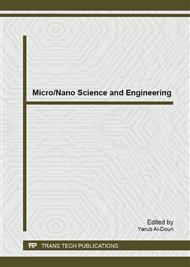p.57
p.62
p.67
p.72
p.77
p.82
p.84
p.88
p.92
Chemical and Thermal Stability of Multiple Ions Doped Non-Stoichiometric Nanoapatite Heat-Treated in CO2 and Air Atmospheres
Abstract:
Nanostructured apatite has been widely used as a bone substitute material due to its close resemblance to human bone mineral. To further mimic biological apatites, multiple ions doped non-stoichiometric nanoapatite has been studied. A nanosized apatite (NAp-2) containing Mg (1.09 wt%), Na (0.15 wt%), K (0.008 wt%) and CO32- (5.18 wt%) was synthesized by a wet precipitation technique. The presence of these ions in NAp-2 was detected using ICP. Broad diffraction peaks of XRD results indicated the presence of nanocrystalline phase pure NAp-2. The primary particle size of the resulted powder was ~ 20 nm, typical of bone crystal size, estimated using Scherrers equation. Based on CHN results, the NAp-2 powders showed a total loss of 51 and 78% of carbonate ions when heat-treated at 900°C in both CO2 and air atmospheres, respectively. This indicates that the heat-treatment in CO2 flux has reduced the carbonate ions lost from the NAp-2. A highly crystalline HA phase was formed in the ionic doped NAp-2 without secondary phases, indicating a thermal stability of this powder at 900°C in CO2 and air atmospheres. Thus, this study demonstrated that a phase pure multiple ions doped nanoapatite was synthesized using a wet precipitation technique.
Info:
Periodical:
Pages:
77-81
Citation:
Online since:
April 2014
Authors:
Keywords:
Price:
Сopyright:
© 2014 Trans Tech Publications Ltd. All Rights Reserved
Share:
Citation:


